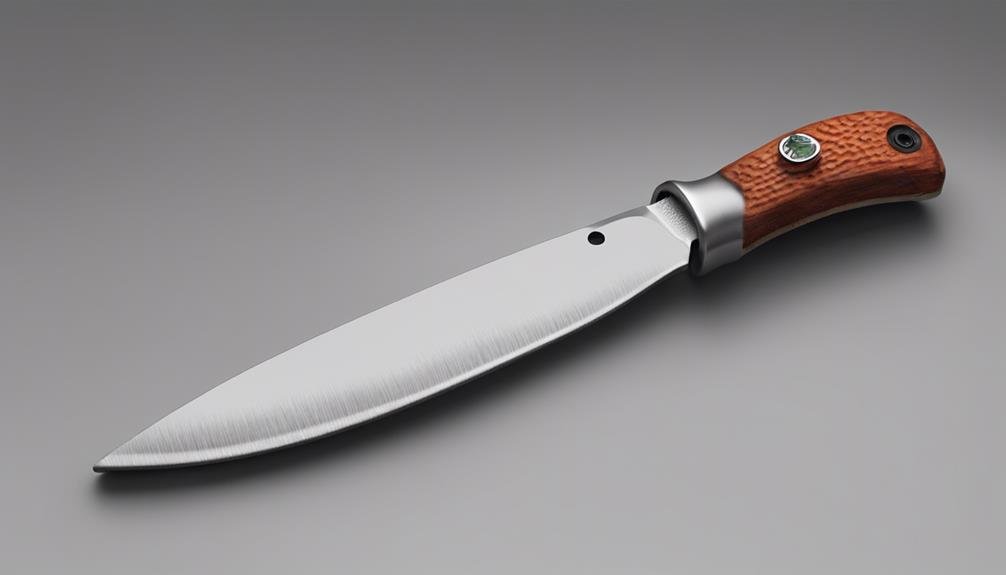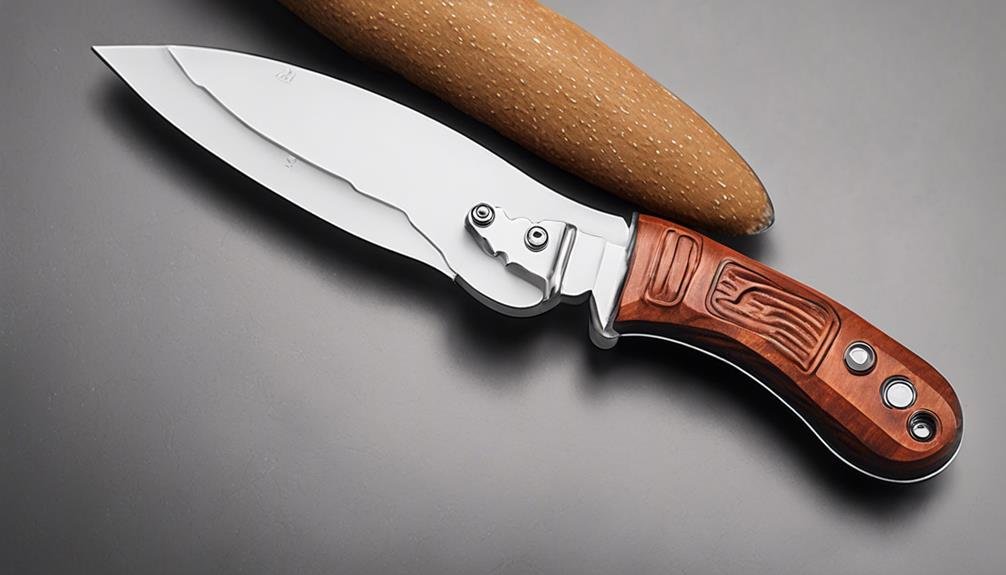Did you know that the design of a fishing knife handle can have a major impact on your overall fishing experience? The ergonomic features of a fishing knife handle are essential for enhancing your comfort, safety, and performance while out on the water. From handle swells to finger guard flares, each element plays a unique role in ensuring a secure and efficient grip. But what specific characteristics should you look for to truly optimize your cutting abilities and prevent mishaps during your next fishing expedition?
Key Takeaways
- Finger grooves hinder grip stability and hand mobility.
- Handle swell enhances comfort and control during filleting.
- Finger guard flare promotes safety and secure grip.
- Thumb ramp ensures precision and steady hand placement.
- Finger choil provides protection and stability for detailed cuts.
Finger Grooves for Secure Grip
Utilizing finger grooves on a fishing knife handle may hinder peak grip stability and hand mobility during prolonged use. While these grooves are intended to provide a secure grip, they can impede the hand’s natural grip by preventing the fingers from locking into position effectively. This limitation compromises the handle’s ability to accommodate all five digits comfortably, potentially reducing the overall effectiveness of grip strength.
Additionally, the design of finger grooves can restrict the hand’s movement, limiting its flexibility and adaptability during knife use. Handles with pronounced finger grooves may lead to discomfort and strain over time, especially when the knife is used extensively.
In the pursuit of enhanced performance and user experience, it’s essential to take into account how finger grooves on a knife handle impact not only the initial grip but also the hand’s comfort and mobility during extended use. A handle that allows for a more natural and unrestricted grip may offer better overall performance and user satisfaction compared to one with rigid finger grooves.
Handle Swell for Comfort
Handle swell in a fishing knife contributes to a comfortable grip by filling the palm, enhancing control, and preventing hand fatigue during extended use. When considering the handle swell of a fishing knife, several key points highlight its importance in providing a superior ergonomic design:
- Enhances Grip Strength: The handle swell guarantees a secure hold, increasing grip strength for more precise and efficient filleting tasks.
- Prevents Hand Fatigue: By filling the palm, the handle swell distributes pressure evenly, reducing strain and averting discomfort during prolonged use.
- Provides Better Control: A well-designed handle swell promotes a natural grip, allowing for enhanced control over the knife for precise cutting motions.
- Efficient Filleting Tasks: Fishing knives with ergonomic handle swells offer a comfortable and secure grip, making filleting tasks more efficient and enjoyable.
Incorporating these elements into the handle design of a fishing knife not only improves comfort but also enhances performance and safety during use.
Finger Guard Flare for Safety

To enhance safety and minimize the risk of accidents, the finger guard flare on fishing knife handles serves as an important feature. The finger guard flare plays a significant role in ergonomic design by preventing slips and protecting fingers while using the knife.
This design element, typically located at the base of the handle, acts as a barrier between your hand and the blade, reducing the chances of injuries during filleting or slicing tasks. Fishing knives may have varying degrees of handle flare, with some offering a more pronounced guard for enhanced protection.
By ensuring a secure grip, the finger guard flare not only safeguards your fingers but also promotes comfortable handling. A properly designed finger guard flare is key to a safe and efficient fishing knife, giving users peace of mind while using the knife for various tasks.
Make sure to choose a knife with an appropriate finger guard flare to prioritize safety and ease of use.
Thumb Ramp for Precision
Enhancing precision in cutting tasks, a well-designed thumb ramp on a fishing knife handle provides a stable platform for your thumb. This feature plays an important role in ensuring accuracy and control during intricate cutting operations. Consider the following benefits of a thumb ramp:
- Stability: The thumb ramp helps maintain stability, allowing for steady hand placement and reducing the risk of hand slippage.
- Controlled Cuts: It enables controlled cuts, essential for detailed tasks such as filleting fish with precision.
- Accuracy: The thumb ramp enhances the accuracy of cuts, contributing to improved overall performance.
- Accident Prevention: By providing a secure grip and steady support, the thumb ramp aids in accident prevention, especially when working on slippery or tough surfaces.
Investing in a fishing knife handle with a well-designed thumb ramp can greatly enhance your cutting experience, making it easier to achieve precise and clean cuts while ensuring safety and efficiency in your fishing endeavors.
Finger Choil for Protection

When seeking high-quality protection during precise cutting tasks, a fishing knife handle with a finger choil offers a secure resting place for your index finger. The finger choil on premium fishing knives provides a safe and ergonomic design that enhances your grip, control, and stability while using a sharp blade. This feature is essential in preventing accidental slips that could lead to injuries during fishing activities.
| Features of Finger Choil on Fishing Knife Handles |
|---|
| Provides a safe resting place for your index finger |
| Offers a secure grip for precise cutting tasks |
| Enhances control and stability while using a sharp blade |
| Protects fingers from accidental slips |
| Commonly found on high-quality fishing knives |
How Does an Ergonomic Handle Enhance the Versatility of a Fishing Knife?
The ergonomic handle greatly enhances the versatility of a fishing knife. Its comfortable grip allows for prolonged use without causing hand strain. This means the knife can be used for a wider range of tasks, making it a valuable tool for any angler.
Frequently Asked Questions
What Are the Ergonomics of Knife Handles?
When considering the ergonomics of knife handles, focus on:
- Grip design
- Thumb placement
- Finger grooves
- Material choice
- Balance point
- Weight distribution
- Texture options
- Hand fatigue
- Customization options
- Durability factors
Guarantee the handle fits comfortably in your hand, provides a secure grip, and minimizes strain during prolonged use. Avoid sharp angles, excessive grooves, or uncomfortable textures that hinder usability and cause discomfort. Prioritize a handle design that enhances functionality and comfort.
The Ultimate J.Marttiini Filleting Knife: Perfect for Fishing and Camping Trips
What Is the Most Comfortable Knife Handle Shape?
When it comes to knife handles, the most comfortable shape resembles a handshake – with a gentle swell in the middle for your palm to rest against. This design, along with smooth curves and textured surfaces, enhances your grip without causing discomfort.
Handle materials, grip design, and weight distribution all play a role in creating a custom fit that guarantees a non-slip coating for best control.
What Makes the Best Knife Handle?
When considering the best knife handle, focus on:
- Handle materials
- Grip design
- Weight distribution
- Texture options
- Finger grooves
- Size variations
- Customization options
- Durability factors
- Balance considerations
- Maintenance requirements
These elements collectively determine the handle’s quality and functionality. Select materials that offer both strength and comfort, incorporate a grip design that enhances control, and guarantee proper weight distribution for balance. Take into account user preferences for texture, size, and customization to optimize the handle design.
What Is the Point of a Fish Knife?
When it comes to a fish knife, its primary purpose lies in its ability to efficiently fillet fish, gut them, scale them, and even chop bones with precision.
This tool is essential for seafood preparation, outdoor cooking, fishing trips, camping meals, and everyday kitchen tasks.
A high-quality fish knife enhances your culinary experience by providing the necessary tools for expertly handling fish, making your cooking endeavors smoother and more enjoyable.
Conclusion
You’ve now learned the key elements that make a fishing knife handle truly ergonomic. Imagine effortlessly slicing through a freshly caught fish with a secure grip, comfortable handle swell, safety finger guard flare, precise thumb ramp, and protective finger choil.
These features work harmoniously to enhance your fishing experience, ensuring a smooth and efficient cutting process every time. Choose a fishing knife with these ergonomic design elements for a superior performance on your next fishing trip.

